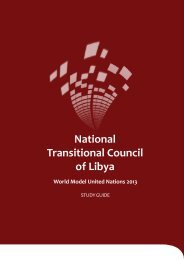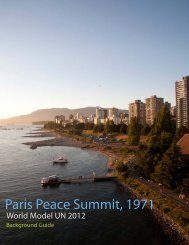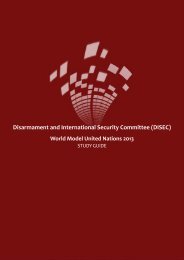Social, Humanitarian and Cultural Committee (SOCHUM)
Social, Humanitarian and Cultural Committee (SOCHUM)
Social, Humanitarian and Cultural Committee (SOCHUM)
Create successful ePaper yourself
Turn your PDF publications into a flip-book with our unique Google optimized e-Paper software.
The regions shown on this map are language hotspots <strong>and</strong> are especially susceptible to language endangerment.<br />
but is considered “definitely endangered,” while<br />
Picard, a language in southern France with 700,000<br />
speakers, is on the list of “severely endangered”<br />
languages. 11<br />
Regardless of the terminology <strong>and</strong> definition, most<br />
endangered languages have a number of similar<br />
features. They generally, though not always, have a<br />
small number of speakers, who constitute a minority<br />
of the population in the region in which the language<br />
is located. The speakers are usually older, <strong>and</strong> some<br />
do not have full competence in the language. One<br />
of the major hallmarks of an endangered language is<br />
lack of transgenerational transmission, which means<br />
that children are not acquiring or using the language.<br />
This situation is worsened by the fact that, because<br />
many members of the community do not speak<br />
the language, <strong>and</strong> the national government of its<br />
respective country does not recognize it, a dominant<br />
language monopolizes public life, including the legal<br />
system, governmental administration, <strong>and</strong> education.<br />
Endangered languages are also defined by the<br />
attitudes that speakers <strong>and</strong> nonspeakers have toward<br />
them. Nonspeakers perceive endangered languages<br />
to be low-prestige dialects while some speakers<br />
of an endangered language often view it, <strong>and</strong> even<br />
their culture, as inferior to the one of the dominant<br />
language <strong>and</strong> culture of the population. Finally, most<br />
endangered languages have little documentation <strong>and</strong><br />
few written records. 12<br />
these signs of language endangerment form the<br />
basis of attempts to classify languages using the<br />
terms listed above. To date, the most st<strong>and</strong>ard criteria<br />
published for determining language endangerment<br />
was created in 2003 by a United Nations Educational,<br />
Scientific <strong>and</strong> <strong>Cultural</strong> Organization Ad-hoc expert<br />
group on the subject. The eight main factors that they<br />
proposed for classifying languages are as follows: (1)<br />
transgenerational transmission, (2) absolute number<br />
of speakers, (3) proportion of speakers within<br />
the total population, (4) loss of existing language<br />
domains, (5) response to new domains <strong>and</strong> media,<br />
(6) material for language education <strong>and</strong> literacy, (7)<br />
governmental <strong>and</strong> institutional language attitudes<br />
<strong>and</strong> policies, including official language status <strong>and</strong><br />
use, <strong>and</strong> (8) community members’ attitudes toward<br />
their own language. the existence of documentation<br />
is another factor that determines how urgently<br />
preservation efforts are needed. 13<br />
Despite the body of literature on the statuses<br />
of specific languages, the problem of language<br />
11<br />
Melbourne Host Directorate PTY LTD | Office of Media <strong>and</strong> Design

















